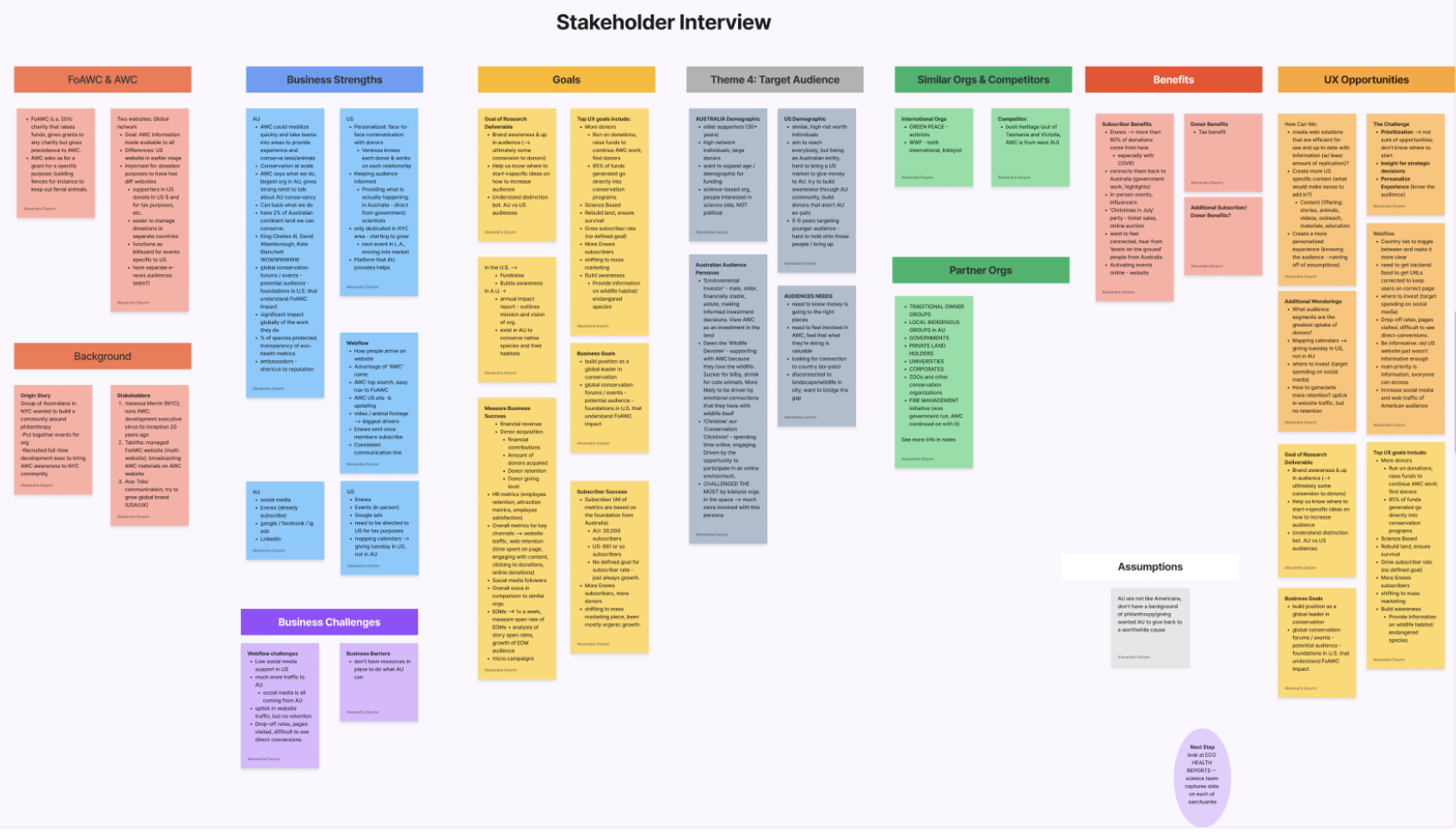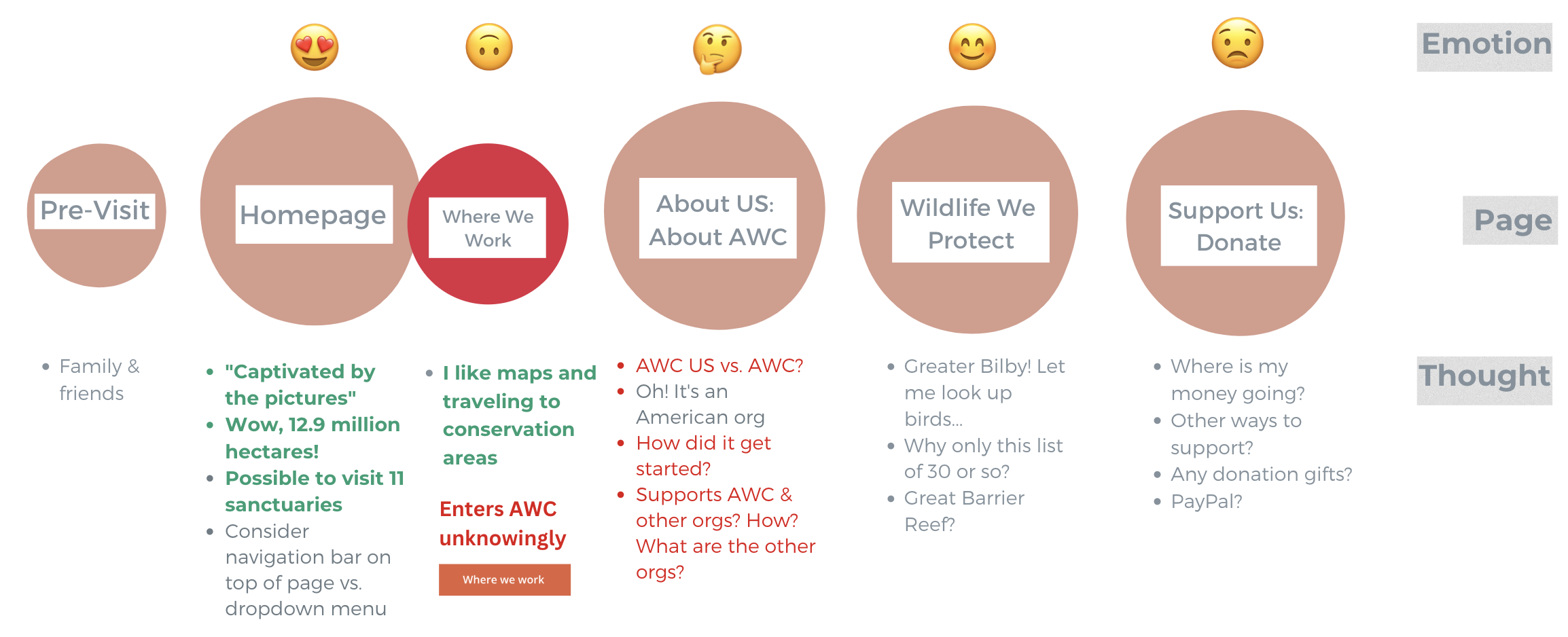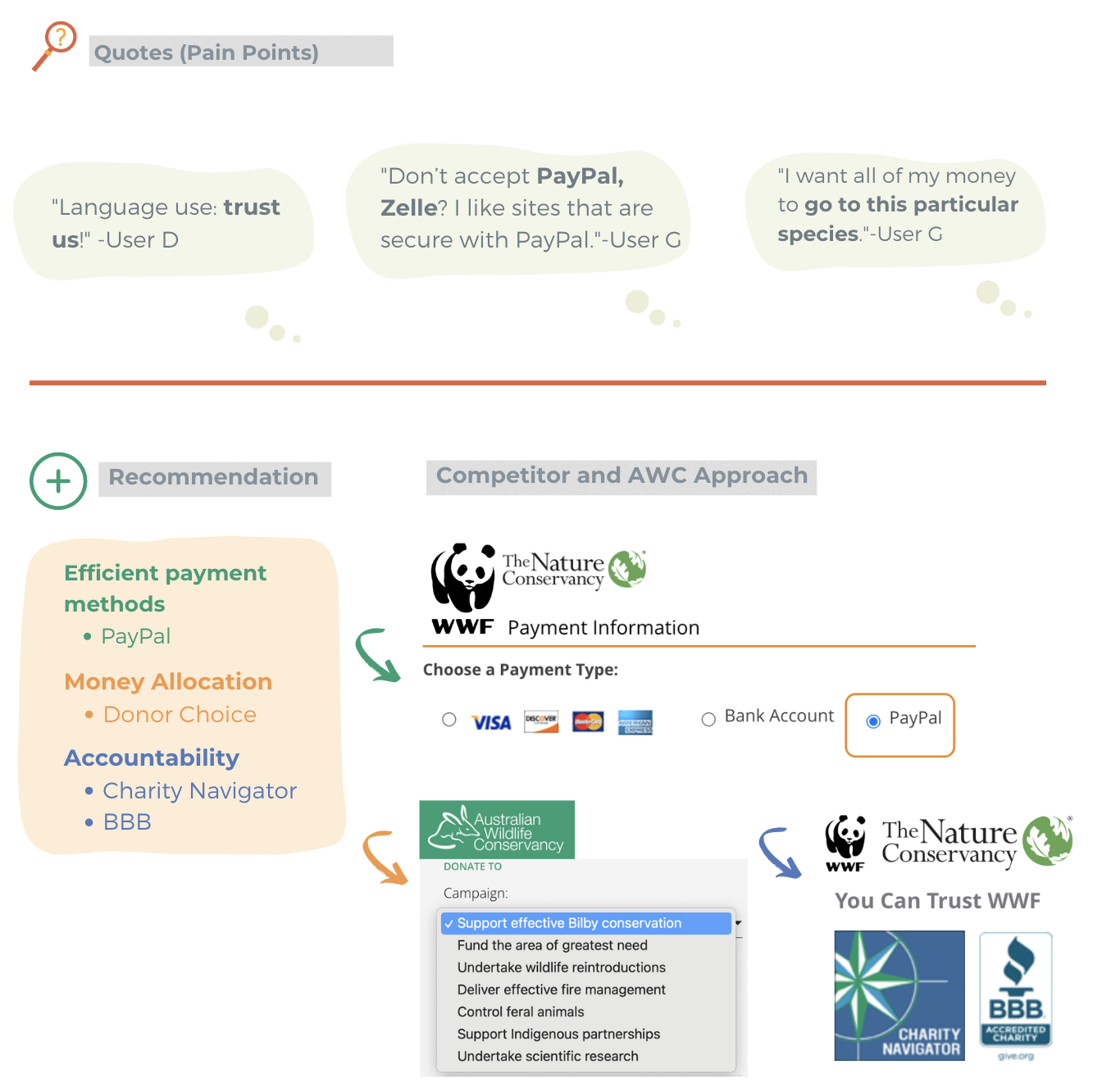Creating a trustworthy brand in conservation
Australian Wildlife Conservancy USA
Australia Wildlife Conservancy USA connects Americans to Australian conservation. I helped AWC USA better understand their American audience, strategize ways to become a global leader in conservation, and provided 7 website redesign recommendations.
Methods & Tools
Competitive Analysis
User Interviews
Expert Interviews
Site Analytics
Journey Mapping
Survey
Personas
Affinity Mapping
Table of Contents
Challenge & Solution | Context & Process | Discovery | Ideation | Solutions Deep Dive | Delivery | Reflection
Challenge
Research and deliver high-priority solutions and strategies that guide Australian Wildlife Conservancy USA’s ability to grow American donors and subscribers and become a global leader in conservation.
Solution
Based on our UX research insights, we designed and prioritized 7 UX recommendations to help AWC USA develop brand clarity, personalized engagement, and deeper trust with their American audience.
This is great. It does reflect the need for us in the trust building. I think the most important thing that I got out of your presentation was who is AWC [USA] in relation to AWC Australia and our story. I think that it’s a very good story to be told and it’s not so I think that will build an emotional connection with people. I think putting that right in the forefront about us, bringing David Attenburough further into the forefront, because I just did an event last week in LA and we played that video of David Attenborough and everybody stopped so that’s a really good point. The transparency of our admin, another great point that is not transparent on the site. [For] AWC here in the US and in Australia to work at a 13-15% admin cost is an incredible achievement and we don’t tell everybody about that. I think that your points throughout this of telling us what we need to highlight is something that we should really consider and implement.
I really am grateful, thank you.
-Venessa Merrin, Principal Officer at AWC
Context
Australian Wildlife Conservancy USA is a US-based non-profit organization on a mission to conserve Australia's unique wildlife and land. FoAWC is the largest private owner and manager of land for conservation in Australia, one of the most biologically diverse nations on the planet with the worst rate of mammal extinction.
AWC USA was born out of an Australian-American group's desire to support Australia's unique wildlife and wild places.
To share their commitment to Australia and strengthen cross-national support, AWC USA hopes to deepen their understanding of their American audience.
Process
To ensure we met our business and UX objectives, we followed a structured research plan and timeline. We rooted our research plan in the double diamond design process, conducted six research methods and synthesized our findings to discover valuable insights.
The three month process was broken down into four phases: planning research, conducting research, synthesizing research, and developing a final report and presentation. Limitations of the project include time, resources, sample sizes, and AWC users for interviews. In response to low AWC user availability for interviews, I personally sourced users who met the criteria of AWC’s target audience.
Discovery
We interviewed three stakeholders to identify high priority business objectives. On a high level, the key business objectives that emerged involve findings ways to grow American donors and subscribers and strategizing how to become a global leader in conservation.
Stakeholder Brief
We surveyed ten current AWC USA donors and subscribers to better understand their motivation to support AWC USA. The results show that users appreciate working closely together to achieve successful outcomes.
Survey
Analyzing AWC USA's site analytics led to a high priority research question:
How might we work on our 'About Us' page and referrals to improve total annual revenue?
The wondering connects to our discovery of the site’s total annual revenue, pages with are the most visited with the highest bounce rate, and what aspects of the site receive the highest level of engagement.
Note: The site analytics are at a high level to respect the privacy of our stakeholder’s data.
Site Analytics
We conducted a competitive analysis to determine AWC USA's strengths and areas of opportunity in comparison to organizations with similar missions. The organizations chosen were referenced by stakeholders and users as competitors or organizations of interest. The organizations include Friends of Australian Bush Heritage, World Wildlife Fund, and The Nature Conservancy. All organizations have an international reach.
In comparing organization, we learned that:
Accountability & Transparency: While there's a lot of information available on AWC USA’s site, some of the most important information is not easily accessible or transparent:
Money Allocation
Orgs that AWC USA partners with
Efficient Payment: Payment options that users find efficient
Offerings & Involvement: Ways for users to support the organization is limited to monetary giving. The site is also limited on incentives in terms of what people receive upon donating.
Competitive Analysis
User Insights
Interviews: Nine 45-60+ minute conversations that deep dive into the American perspective on conservation
The nine awesome folks behind the user research came from a personal network of family/friends (3), referrals of family/friends (5), and a platform called Respondent (1).
After conducting the user interviews, we synthesized the research using affinity mapping. The synthesis led to grouping participants into two main target audiences: 1. Conservation Professionals 2. Conservation Enthusiasts. We then translated the synthesis into comprehensive user personas.
We learned that:
Trust: Conservation enthusiasts are most motivated by trust in a conservation organization
Impact: Conservation professionals are motivated by collective impact and measurable results.
Personas
User Mental Model: What are the big questions our users are pondering?
Letting inquiry be our guide, we encouraged our users to ask questions as they explored AWC USA’s website. We then organized the reoccurring questions of our users into four categories:
AWC USA Story: Users want to know about how AWC USA got started, how they are different from AWC, and more about AWC's story.
Support: Users want to know where their money is going, that the transaction is secure, and they want to get involved in ways that aren't monetary.
Alliances: Users want to know who AWC USA supports (in addition to AWC), how they support other orgs, and who is involved with the new model for conservation
Australian Focus: Users want to know why they should give their money to Australia when many places are in need, if AWC USA supports the Great Barrier Reef, and what other animals they support other than the thirty or so listed on the site.
During our user interviews, we documented the experience of our users as they moved through AWC USA’s website. We learned that:
Strengths
Aesthetic: Upon entering the site, majority of users were impressed by the site's aesthetic & imagery
Land: Folks were also impressed by the amount of land being preserved and the option to visit some of the sanctuaries.
Pages of Interest: Other pages of interest that users visited include 'Our Board', 'Wildlife We Protect', 'Kids' Corner', 'Careers', and 'Newsroom'
Confusion
AWC USA vs. AWC: Users couldn't tell how AWC USA was different from AWC. They felt the sites were pretty identical and most of the social media links were AWC's, not AWC USA specific.
Off site navigation unknowingly: Two users pivoted unknowingly to AWC via the "Where We Work" button on the homepage. Other users looked up AWC through a Google search.
AWC USA's Story: Users felt the site was shy on information about AWC USA's story including origin, org's they support, and success
Donation allocation: User's want to know where there money is going
Payment & Support options: User's want recognizable payment and support options
User Journey Map
Journey synthesis
Individual user journeys
Ideation
The synthesis of our research led to the development of our core UX objectives that we defined in ‘How Might We’ statements.
How might we meet the transparency and efficiency standards of our audience?
How might we make users feel safe and comfortable during every step of the donation process?
How might we develop brand clarity for our audience?
How might we personalize the user experience?
We then developed a priorities intersection diagram with the high-priority needs of our stakeholders and users. The priorities intersection shows the core of our problem focuses on trust, brand clarity, and a more personalized experience.
We prioritized a list of 10 potential solutions and developed a prioritization matrix to showcase each solution’s level of urgency and the time it would take to implement and see results.
Clarity. Personalization. Trust.
6 High Priority UX Recommendations
Clarity
Pain Point
Based on the research insights, we discovered the ‘About Us’ page had a high bounce rate and limited information about AWC USA's story.
Solution
Revise the about us page by adding an AWC USA origin story, impact report, subscription option (CTA), video of AWC's vision with David Attenborough, link to AWC's History.
Pain Point
Folks are confused about who the organization partners with.
Solution
Clarify orgs AWC USA support, specify amount that goes toward AWC, orgs in bold font with links and video Attenborough, link to AWC's History.
Solution
Clarify orgs AWC USA support, specify amount that goes toward AWC, orgs in bold font with links and video Attenborough, link to AWC's History.
Pain Point
Support options focus mainly on fiscal transaction.
Solution
Add support options & offerings: travel, volunteer, events, merchandise, adopt-an-animal (see competitor offerings).
Personalization
Pain Point
On the donation page, folks feel there is limited donation allocation transparency & organization.
Solution
Offer donation transparency (percentage to conservation), organize information with links to organization that receive money and use bullets and bold font to emphasize where donations are going.
Trust
Pain Point
On the donation page, folks feel there are limited check-out options and accountability measures.
Solution
Offer efficient payment options (ex PayPal), donor choice (ex. donate to campaign or species), & show accountability measures (ex. Charity Navigator).
Pain Point
American users are unfamiliar with AWC USA's brand, including those professionally involved in US/AU/global conservation for 30+ years.
Solution
Collaborate with orgs and foundations that are recognizable to an American audience. Consider joining a conservation alliance such as the Conservation Measures Partnership which includes global conservation leaders, including American based organizations like WWF and The Nature Conservancy. Showcase collaborations in the media to increase referrals which is currently one of AWC USA's highest engagement pathways.
We recommended that AWC USA consider joining a conservation alliance such as the Conservation Measures Partnership (CMP). We defined the value of the partnership, explaining a global network can improve visibility and trust with an American audience. We also provided a way to connect with folks in the CMP.
Delivery
At the end of our three month project, we presented our findings to the stakeholder and provided a final research report.
Reflection
The UX research project with AWC USA further developed my research, synthesis, and ideation skills. I learned how to select, conduct, and synthesize six different research methods under time restraints.
Resourcefulness: When faced with recruitment challenges, I sourced candidates from my network and Usabilityhub. Asking my personal network for leads to people involved in conservation led to five additional interviews and a deeper understanding of American and global conservation measures and partnerships. I also co-created a survey to share with the client's existing customers as an alternative way to reach my target audience.
Staying organized: One of the challenges in using six methods in a short period of time is organizing the information to tell a clear story with strong evidence. I recorded and transcribed each interview which allowed me to go through the information multiple times to extract key findings. Using a variety of synthesis methods allowed me to find reoccurring problems to best define high priority pain point worth solving.
Continued research: In terms of next steps, although we received insights from AWC USA’s direct donors and subscribers through a survey, it would strengthen the research to conduct one on one interviews with a direct audience.
























